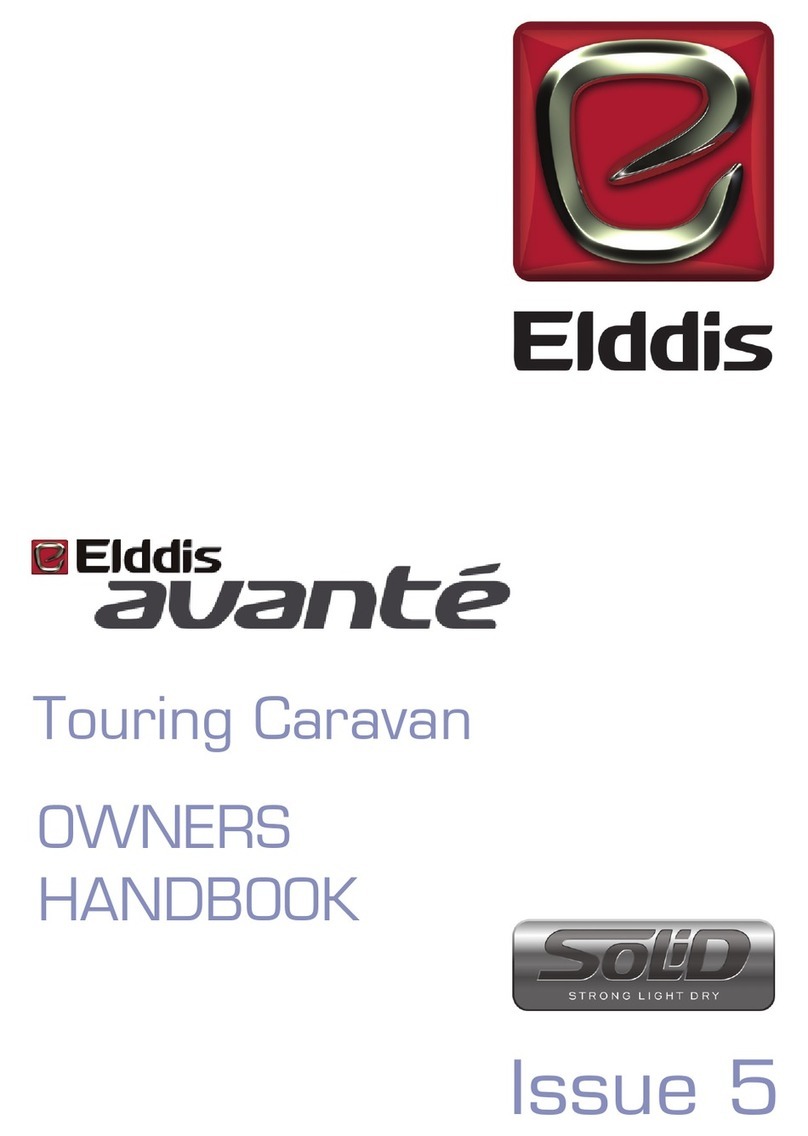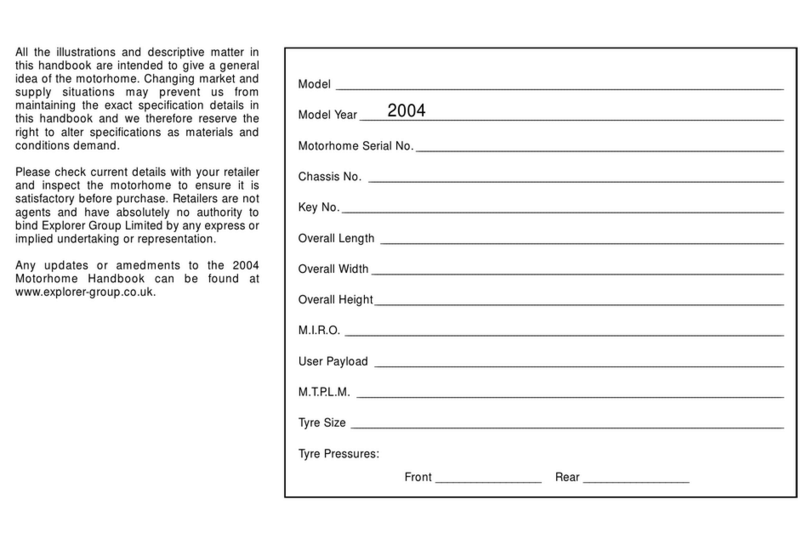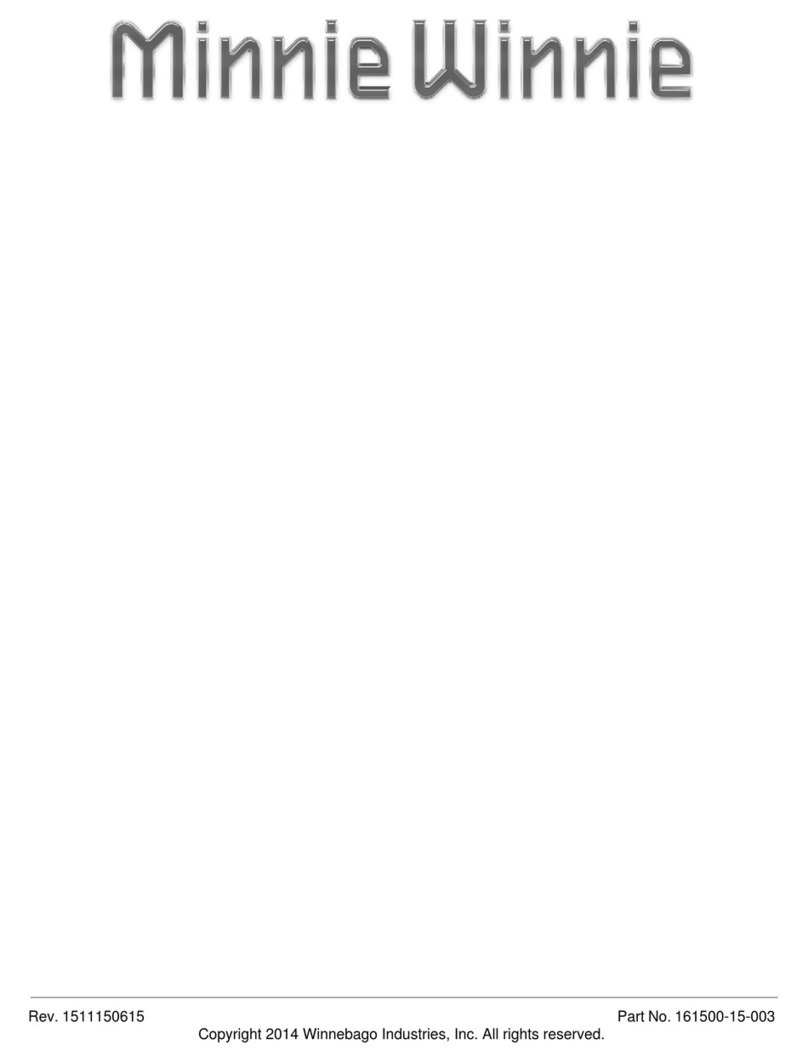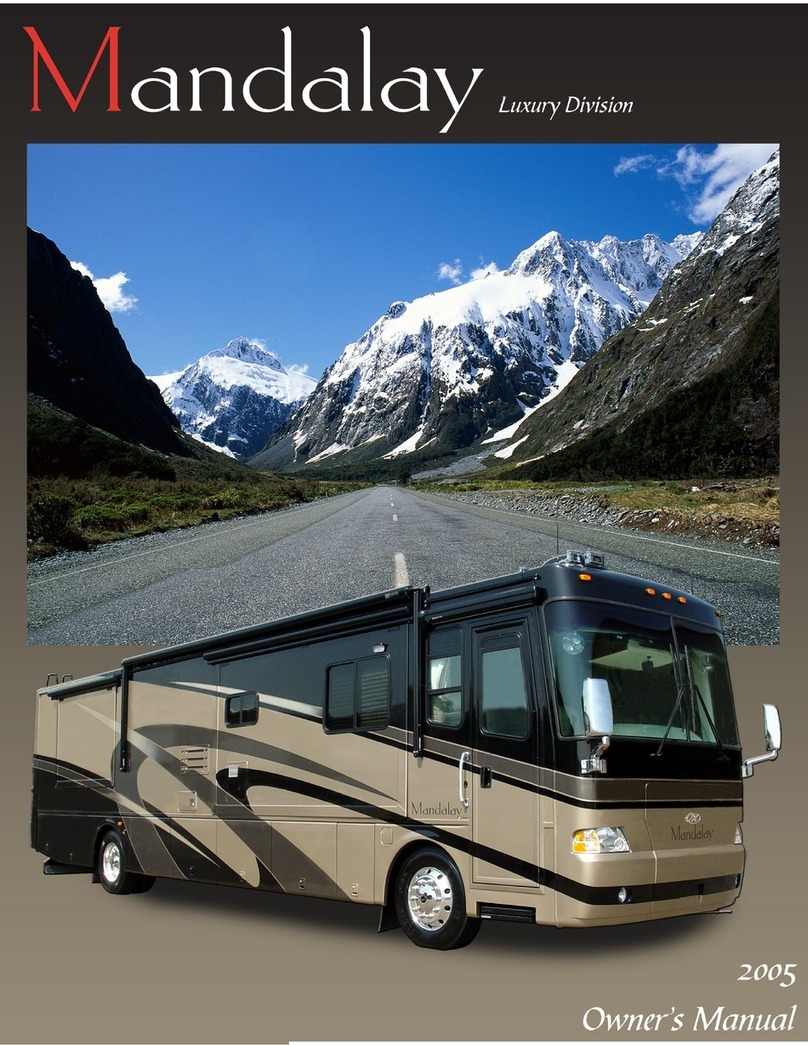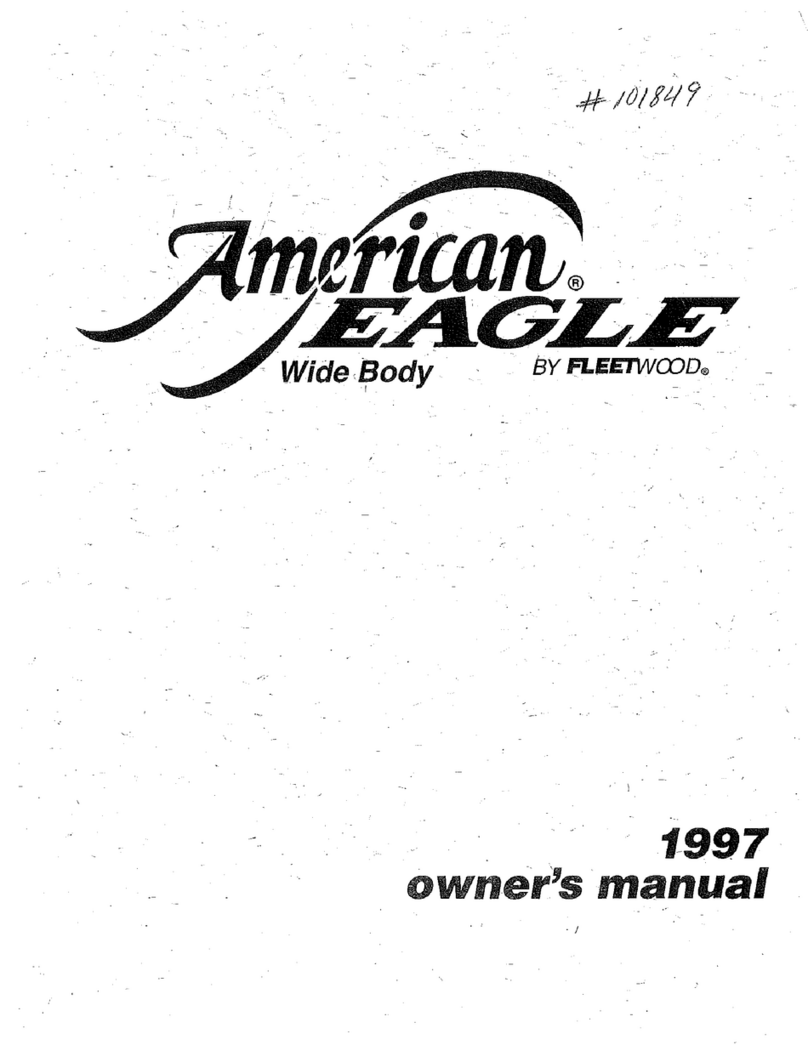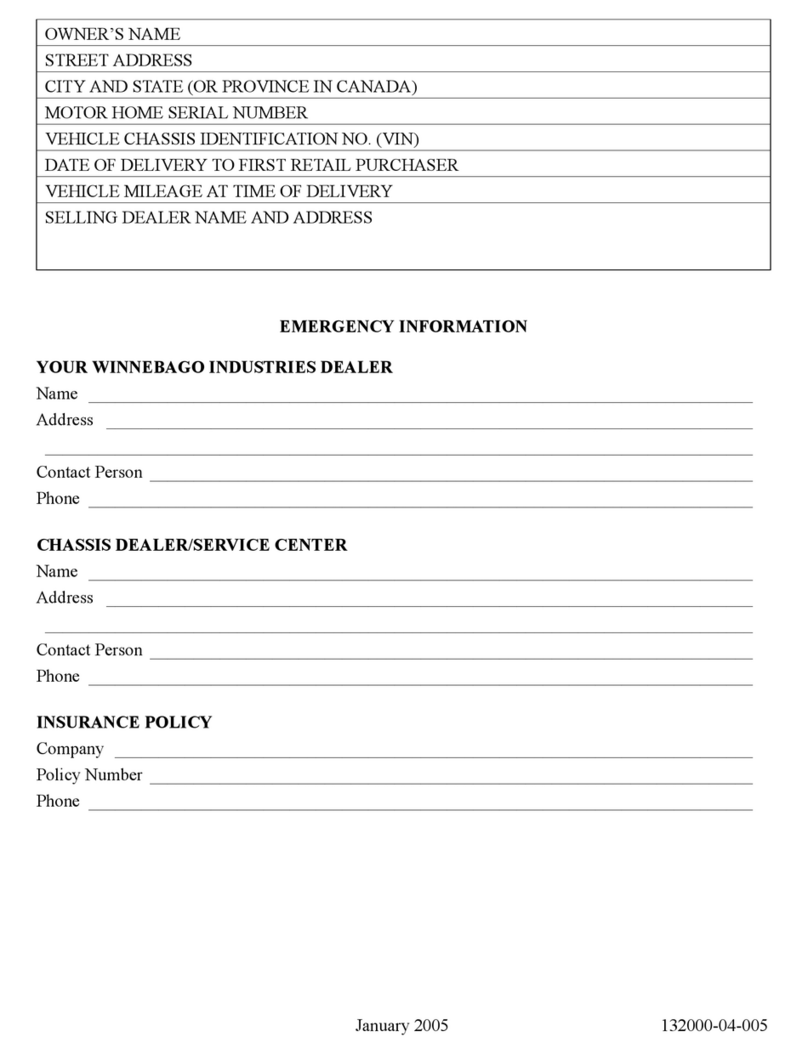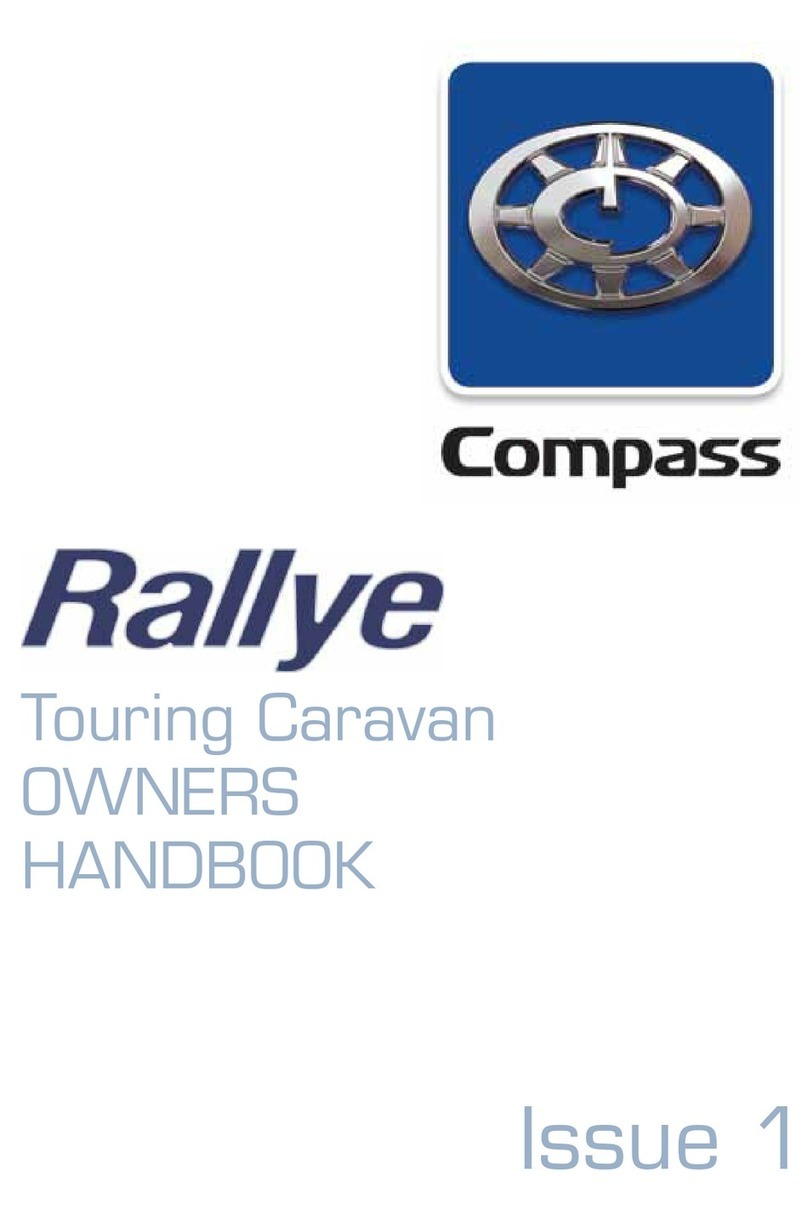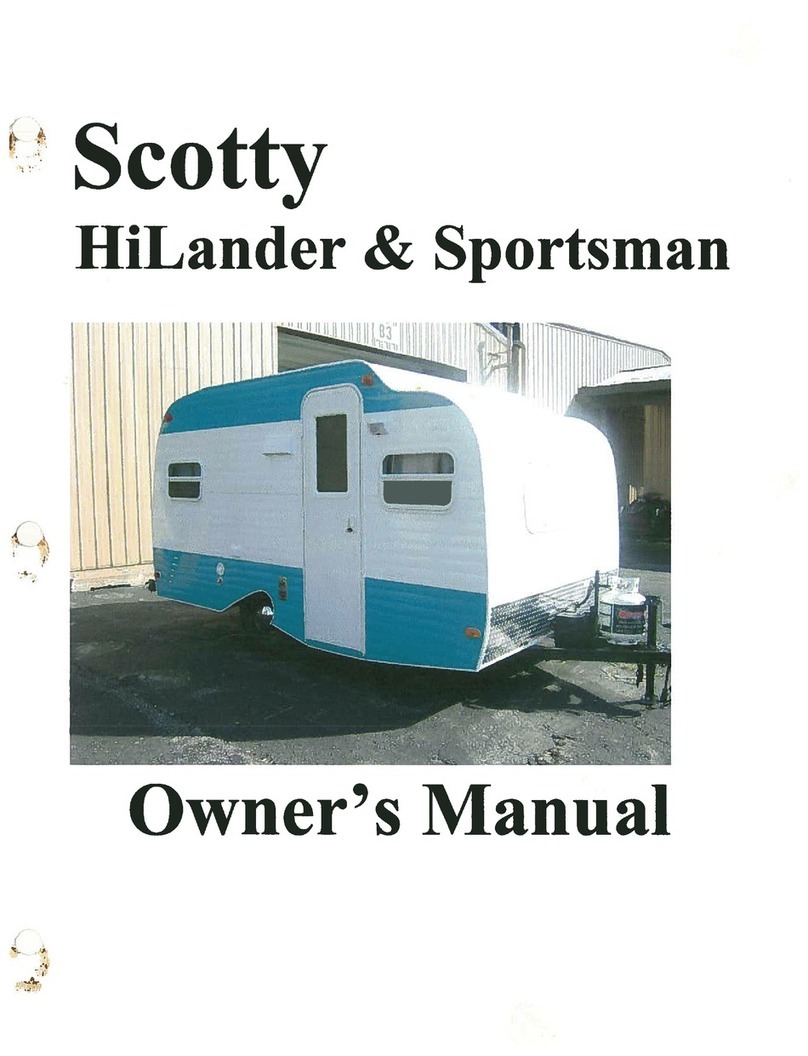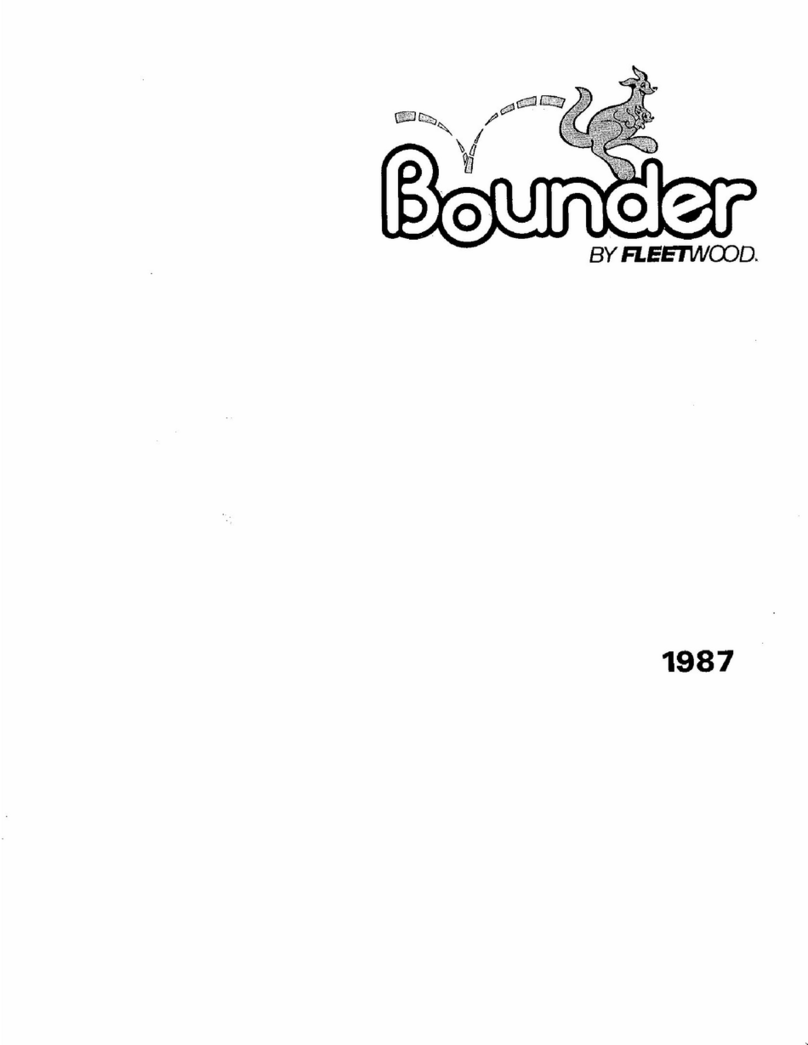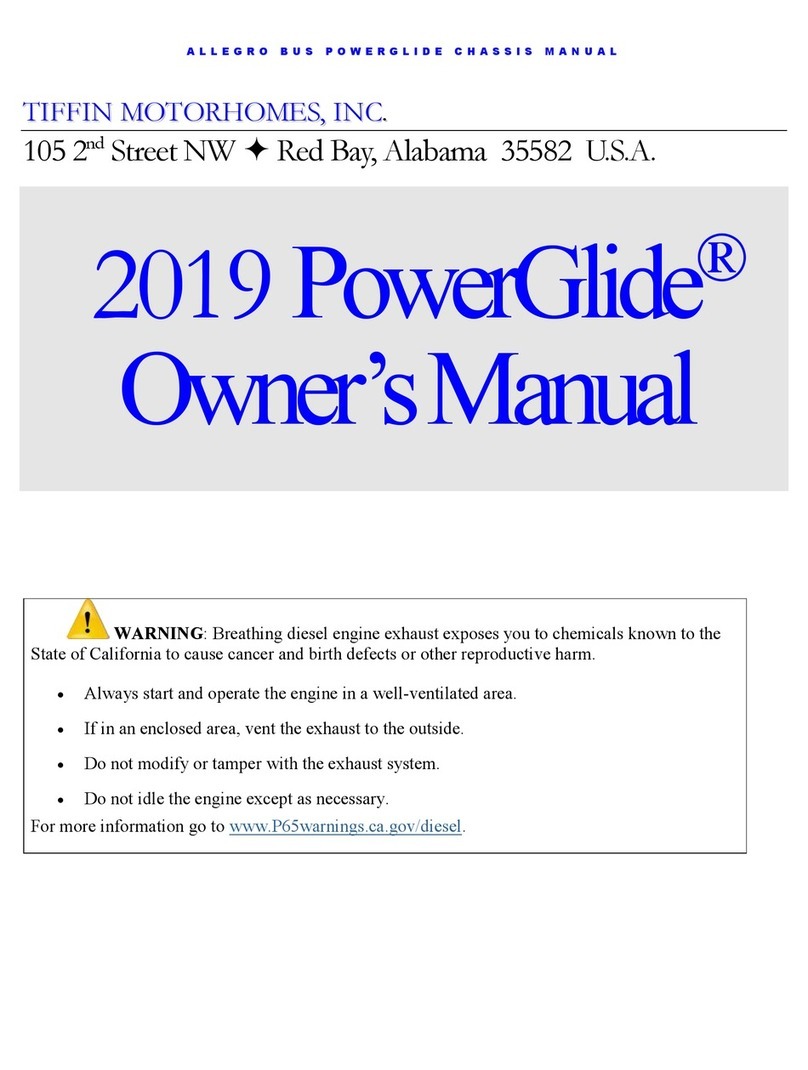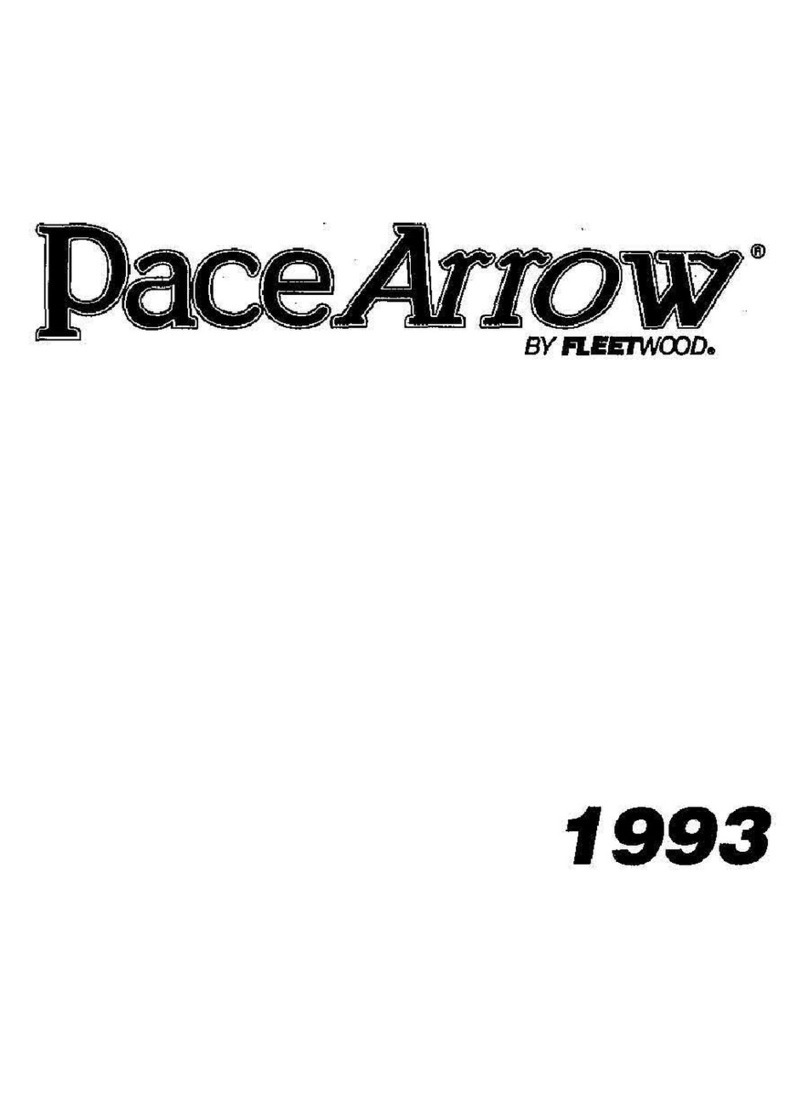elddis Buccaneer User guide

Buccaneer
Touring Caravan
OWNERS
HANDBOOK
The Explorer Group Limited Delves Lane, Consett, Co. Durham DH8 7PE
Telephone: 01207 699000 • Facsimile: 01207 699001 • www.explorer-group.co.uk
All the illustrations and descriptive matter in this guide are intended to give a general idea of the
caravan. Changing market and supply situations may prevent the manufacturer from maintaining
the exact specifications and details in this handbook and we therefore reserve the right to alter
specifications and materials as conditions demand.
Retailers are independent of the manufacturer and have absolutely no authority to bind the
manufacturer by any express or implied undertaking or representation.
Model Year 2018
Issue 1

CONTENTS-1
CONTENTS
WELCOME AND INTRODUCTION ........ 1-1
Model Year Designation .......................... 1-1
Buccaneer Technical Approvals .............. 1-1
GENERAL SAFETY ............................... 2-1
Please read before using your
new caravan. ........................................... 2-1
Ventilation ............................................... 2-2
High-Level Ventilation ............................. 2-2
Low-Level Ventilation .............................. 2-2
Ventilation in Separate Bedrooms ........... 2-2
Gas Dispersal Holes ............................... 2-2
Petrol/Diesel Fumes ................................ 2-2
Fire Safety ............................................... 2-2
Fire Extinguishers ................................... 2-2
In Case Of Fire ........................................ 2-2
Fire Retardant Foams ............................. 2-2
Escape Paths .......................................... 2-2
Your Caravan Payload Explained ........... 2-3
PREPARING FOR THE ROAD ............... 3-1
Caravan Towing Vehicle Weight Ratio .... 3-1
Loading ................................................... 3-1
Internal Loading & Checks ...................... 3-1
External Loading & Checks ..................... 3-2
Pre-Tow Checklist & Hitch-Up ................. 3-2
Use of Your Caravans Breakaway Cable 3-5
TOWING AND DRIVING ......................... 4-1
Reversing ................................................ 4-1
Speed Limits ........................................... 4-1
Setting Off ............................................... 4-1
Caravan Handling ................................... 4-1
Motorway Driving .................................... 4-2
Towing Covers ........................................ 4-2
Tyre and wheel checks ........................... 4-2
ARRIVING ON SITE ............................... 5-1
Check Site Regulations ........................... 5-1
Selecting a Pitch ..................................... 5-1
The E&P Hydraulics Levelsystem ........... 5-1
GETTING STARTED .............................. 6-1
Electricity ................................................. 6-1
Power Supply Charger ............................ 6-1
12v Systems: .......................................... 6-1
Generator/Charger .................................. 6-1
Electricity Mains Supply .......................... 6-1
Connecting To Mains Supply On
Arrival at Site ........................................... 6-1
Disconnecting Mains Supply When
Leaving Site ............................................ 6-2
Overseas Electrical Connection .............. 6-2
Gas Safety Advice ................................... 6-3
Facts about LPG ..................................... 6-3
Awning Spaces, LPG and Appliance
Exhaust ................................................... 6-3
LPG Gas System .................................... 6-3
Gas Supply ............................................. 6-4
Connection .............................................. 6-4
Changing a Gas Cylinder ........................ 6-4
Auto Changeover Gas Regulator ............ 6-5
High Pressure Gas Hoses ...................... 6-6
Whale High Flow Pump with Intelligent
Control® .................................................. 6-7
ELECTRICAL SYSTEM .......................... 7-1
12v Power Supply ................................... 7-1
Battery Installation .................................. 7-1
Battery Maintenance ............................... 7-1
Generators / Charger .............................. 7-1
230v Power Supply ................................. 7-2
Mains Unit ............................................... 7-2
Resetting the RCD .................................. 7-2
Automatic Charging System ................... 7-2
Internal Lights ......................................... 7-2
Maximum Power Ratings for Internal
Lights ...................................................... 7-2
Connecting a Solar Panel
and/or Satellite Dish (Option only) .......... 7-3
External Solar Panel Connection ............ 7-3
External Satellite TV Connection ............ 7-3
HOW TO USE YOUR CARAVAN’S
EQUIPMENT ........................................... 8-1
Electrical Control Panels ......................... 8-1
Buccaneer ............................................... 8-1
Combined Cooker, Hob, Oven and Grill .. 8-2
Using the hotplate gas burners ............... 8-2
Using the Electric Hotplate ...................... 8-3
Using the Grill ......................................... 8-3
Using the Oven ....................................... 8-4
Oven Temperature Control ...................... 8-4
Refrigerator ............................................. 8-6
Alde Heating ........................................... 8-9
Alde 3020 Control Panel ......................... 8-9
Microwave ............................................. 8-12
Battery Charger ..................................... 8-13
Smoke Alarm ......................................... 8-13
Nuisance Alarms ................................... 8-14
Battery Replacement ............................ 8-14
Cleaning your alarm .............................. 8-14
Carbon Monoxide Alarm ....................... 8-15
Recognising Alarm Signals and
Warnings ............................................... 8-15
MY2018/Buccaneer

CONTENTS-2
CONTENTS
Using your Alarm ................................... 8-15
Switching on your CO Alarm ................. 8-15
Re-setting the Alarm ............................. 8-15
Replacement of Batteries ...................... 8-15
Carbon Monoxide Alarm Procedure ...... 8-16
Maintenance of your alarm ................... 8-16
Thetford C-260 Cassette Toilet Range .. 8-17
Preparing for Use (standard) ................ 8-17
Preparing for Use with Optional
Features ................................................ 8-17
Using the Toilet (Standard) .................... 8-19
Using the Toilet with Optional Features . 8-19
Emptying ............................................... 8-19
Emptying with Optional Features .......... 8-19
Cleaning and Maintenance ................... 8-20
Toilet Bowl ............................................. 8-20
Waste Holding Tank .............................. 8-20
Cleaning and Maintenance for
Optional Features ................................. 8-21
Winter operation .................................... 8-21
Storage ................................................. 8-21
Toilet Unit Malfunctions ......................... 8-21
Rooflights .............................................. 8-23
The Omivent (12v) Rooflight ................. 8-23
The Heki 2 Rooflight ............................. 8-23
Midi Heki Rooflight ................................ 8-24
MPK Rooflight ....................................... 8-25
Windows ............................................... 8-26
Polyplastic Window Opening ................ 8-26
Blinds & Flyscreens .............................. 8-26
Door Flyscreen ...................................... 8-26
Shower .................................................. 8-27
Taps ...................................................... 8-27
Kitchen Taps .......................................... 8-27
Washroom Taps and Showers .............. 8-27
Gas Locker Door ................................... 8-28
Internal Doors ....................................... 8-28
Toilet/Shower Room Doors ................... 8-28
High Level Locker ................................. 8-28
Magnetic Catches ................................. 8-29
Sprung Hinges ...................................... 8-29
Room Divider ........................................ 8-29
Bed Make-up ......................................... 8-30
Front Wrap Round Seating (Option) ..... 8-33
Lift Up Bed Extensions (where fitted) .... 8-33
Removable Drawer Locker ................... 8-33
Radio with MP3 Connectivity ................ 8-33
Teleco TV Aerial .................................... 8-34
How to use your TV Aerial ..................... 8-36
Digital TV set-up guide .......................... 8-36
Connect Aerial and Power .................... 8-36
Troubleshooting Guide .......................... 8-36
Protect - Autowatch Alarm System ........ 8-38
Basic Operation Arming the System ..... 8-38
Disarming the System ........................... 8-38
Panic Alarm ........................................... 8-38
Emergency Disarm ............................... 8-38
Silent Arm and Disarm .......................... 8-38
Sensors ................................................. 8-38
Passive Infra Red Sensor ..................... 8-38
Al-Ko Trailer - Control ........................... 8-39
SECURITY .............................................. 9-1
Caravan Theft ......................................... 9-1
Tracker Retrieve ...................................... 9-1
CRIS - The Caravan Registration and
Identification Scheme .............................. 9-1
Al-Ko Secure Wheel Lock (Option) ......... 9-2
Window & Chassis Marking .................... 9-4
Electronic Tagging ................................... 9-4
CARE OF YOUR CARAVAN ................ 10-1
Exterior Cleaning .................................. 10-1
Wheels .................................................. 10-1
Glass Fibre Reinforced Plastic (GRP) .. 10-1
Acrylic Windows .................................... 10-1
Window Blinds & Flyscreens ................. 10-1
Winterisation/Storage ............................ 10-1
ABS - A Frame Cover, Wheel Spats
& Panels ................................................ 10-1
Interior Walls ......................................... 10-2
Furniture ................................................ 10-2
Cooking Equipment ............................... 10-2
Soft Furnishings .................................... 10-2
Winterisation and Storage ..................... 10-3
Shower Trays, Shower Room and
Wash Basin Fittings .............................. 10-3
Cleaning of all Taps ............................... 10-3
Water Containers .................................. 10-4
Water Systems - Sterilisation ................ 10-4
Thetford Toilet ....................................... 10-4
Chassis Mounted Spare Wheel Carrier 10-5
Tyres ..................................................... 10-5
Pressures .............................................. 10-5
Tyre Wear and Damage ........................ 10-5
Changing a Wheel ................................ 10-5
Jacking .................................................. 10-6
Lubrication ............................................ 10-6
The Alko Caravan Chassis .................... 10-7
Chassis members ................................. 10-7
Drilling or Welding of Parts or
Accessories ........................................... 10-7
Independent Suspension ...................... 10-7
Coupling Head ...................................... 10-7
Secondary Braking (Breakaway cable) . 10-7

CONTENTS-3
CONTENTS
Brake Drum/hub Assembly ................... 10-7
Operating instructions ........................... 10-8
Braking system adjustment ................. 10-10
STORAGE ............................................ 11-1
Long Term & Winter Storage .................. 11-1
Caravan Covers ..................................... 11-1
Power Drain ........................................... 11-1
CARAVAN WARRANTY COVER ......... 12-1
Non Warranty Repairs ........................... 12-3
Remedial Work ...................................... 12-3
CARAVAN CONSTRUCTION -
MAIN COMPONENTS .......................... 13-1
Alko Chassis ......................................... 13-1
Braking System ..................................... 13-1
Solid Construction Body Shell ............... 13-1
Windows ............................................... 13-1
Insulation ............................................... 13-1
Front Panel and Gas Bottle Locker
Door ...................................................... 13-1
Awning Channel .................................... 13-1
EQUIPMENT LIST ................................ 14-1
Buccaneer ............................................. 14-1
WIRING DIAGRAM - BUCCANEER .... 15-1
Road Lights - Buccaneer ...................... 15-2
GENERAL QUESTIONS ...................... 16-1
GLOSSARY .......................................... 17-1
SERVICE DOCUMENTS ...................... 18-1
NOTIFICATION OF CHANGE OF
OWNERSHIP ........................................ 19-1
NOTIFICATION OF CHANGE TO
NAME AND ADDRESS ........................ 20-1
USEFUL ADDRESSES ........................ 21-1
INDEX ................................................... 22-1

CONTENTS-4
CONTENTS

1-1
INTRODUCTION
WELCOME AND INTRODUCTION
Congratulations on choosing a Buccaneer
Touring Caravan.
This Owner’s Handbook has been prepared
for your guidance to help you derive the
greatest amount of pleasure from the use of
your caravan and your leisure time. We
strongly recommend that you read this guide
thoroughly so that you are fully aware of all
the caravan’s features, equipment and
systems.
Additional information and detailed appliance
instruction manuals are also contained in
your Owner’s Information Pack which can be
found within the kit box supplied with your
caravan.
Your new Buccaneer caravan has been
designed as a recreational vehicle and is
intended for recreational use only. It is not
intended for business, hire use or for
permanent habitation. Elddis accepts no
liability if the caravan is used for any
purpose other than recreational/holiday
use. Any use other than recreational/
holiday use will invalidate your warranty.
Your caravan has been designed for towing
behind a normal motor car. Additional care
should be exercised when towing with a 4x4
because of the ‘off-road’ nature of the
suspension. Owners should not tow their
touring caravans with commercial vehicles.
When selecting a towing vehicle it is
recommended that you consult the Caravan
Towing Code, which is available from the
NCC.
By following the instructions provided in this
handbook and maintaining your caravan in a
first class roadworthy condition, you are sure
to have many years of carefree use.
To ensure the very best quality and reliability
all touring caravan designs and new
developments are rigorously tested.
Therefore Elddis will accept no liability or
uphold the warranty if the caravan is altered
or modified in such a way that would
adversely affect the reliability.
Please note: It is a condition of your
warranty that the caravan must have an
“annual service” carried out by a Elddis
approved Retailer / Service Centre or NCC
Approved workshop or NCC equivalent
standard as set out in this handbook and a
record is kept. Pages are provided in the
back of this guide, for your assistance.
An Elddis Approved Retailer / Service Centre
will be able to supply any replacement parts
for your caravan, should the need arise, and
in most cases any accessories you may
require.
Please note: It is not possible to purchase
replacement parts direct from Elddis .
Changing market and supply situations may
prevent us from maintaining the exact
specification details in this guide and we
therefore reserve the right to alter
specifications as materials and conditions
demand.
Enjoy your new caravan
Model Year Designation
All Touring caravans manufactured by Elddis
are designated by their model year. The 2018
model year runs from 1st September 2017 to
31st August 2018.
Buccaneer Technical Approvals
All Elddis Caravans have been European
Commission Whole Vehicle Type Approved
via the Vehicle Certification Agency (VCA).
In order to ensure your new caravan is safe
to use, Elddis are members of and have been
inspected by the following bodies.
NCC who operated a certification scheme to
ensure compliance with the European safety
standards for caravans.
National Inspection Council for Electrical
Installation and Contracting (NICEIC) who
carry out an annual inspection of Elddis
electrical installations within caravans.
Gas Safe Register™ approved installers
carry out an annual inspection to ensure that
the gas installations carried out by Elddis fully
comply with all relevant regulations and
standards.
Elddis has also obtained ISO9001:2008
accreditation and this is audited by SGS UK
Limited

1-2
INTRODUCTION

2-1
GENERAL SAFETY
GENERAL SAFETY
Please read before using your new
caravan.
In order for you to get the most out of your
new Elddis caravan it is necessary for you to
be aware of the following:
(i) Do not obstruct ventilators and clean
them regularly, it is advisable to clean
and check all the ventilators annually
for blockages and where necessary
rectify any blockages found.
(ii) Inspect the high pressure flexible gas
hose (available from your retailer)
regularly for deterioration and renew
as necessary, with an approved type,
in any case no later than the expiry
date stated on the hose.
(iii) Ensure the gas supply and all
appliances are turned off before towing
your caravan.
(iv) If your caravan has been fitted with a
gas BBQ point it must be only used for
its intended purpose. Do not use a
gas barbeque within an awning.
(v) Never allow modification to your gas or
electrical system unless qualified
persons carry them out. All
modification to the gas system should
be carried out by a Gas Safe
Register™ approved gas fitter. Any
modifications carried out on the
electrical system must be carried out
by an electrician on the roll of the
NICEIC or be a member of the ECA.
Never use portable cooking or heating
equipment inside your caravan. Do not
use your fitted cooking equipment as
heating at any time.
(vi) In the interest of safety, replacement
parts for an appliance should conform
to the appliance manufacturer’s
specifications and must be fitted by
them or an authorised agent.
(vii) If you suspect there is a gas leak
please open all the windows then
vacate the caravan. Turn off the gas
container if safe to do so, then contact
your nearest Elddis Retailer to arrange
for them to check the gas system.
(viii) It is recommended that you provide a
dry powder fire extinguisher complying
with ISO 7165 of at least 1KG capacity
by the exit door and a fire blanket next
to the cooker. Ensure you read the
‘advice to occupier label’ fitted to your
caravan usually found on the inside of
the wardrobe door.
(ix) Never exceed your caravans Maximum
Technical Permissible Laden Mass.
(see Caravan Towing Vehicle Weight
Ratio)
(x) The laden nose weight for your
caravan should not exceed the lower
of the following:
• Towing vehicles maximum nose
weight
• Tow bar maximum nose weight
• The caravan’s maximum nose
weight.
(xi) Ensure heavy and large items are
secured before towing your new
caravan to reduce the risk of damage
being caused while the caravan is in
motion.
(xii) Pull out worktop extensions, where
fitted, are only designed to take a
maximum weight of 6kgs.
(xiii) When your caravan is connected to
your towing vehicle it should be level
or slightly nose down.
(xiv) Where high level bunks are fitted, care
should be taken when used by
children. The protection against falling
out must be in place when the bunk is
used.
(xv) When your caravan is loaded to its
MTPLM and the weight distributed in
accordance with the handbook, your
caravan is designed to be towed at a
maximum speed of 100kmh/60mph.
(xvi) It is illegal to tow your caravan
whilst it is occupied.
(xvii) If your caravan is fitted with a lift up
bunk it is designed for a maximum
weight of 11 stone and is not suitable
for children under 6 years old without
supervision.
(xviii) Do not leave children under 14 years
of age unattended in your caravan.

2-2
GENERAL SAFETY
(xix) Your vehicles MIRO is calculated with
no water on board. To travel with water
you must take account of the water in
your vehicle payload. 1 litre of water =
1Kg.
VENTILATION
All caravans manufactured by Elddis are
ventilated at both high and low level in
accordance with BSEN 721 Safety
Ventilation.
High-Level Ventilation
This is always provided by fixed ventilation
within the fitted roof skylight. These roof
skylights should be cleaned annually by use
of a small brush to remove any dust that may
have accumulated around the mesh fitted.
On some roof skylights the mesh can be
easily removed to aid cleaning. On fan-
assisted roof skylights it is essential that the
fan is switched off prior to cleaning.
Low-Level Ventilation
Low level ventilation is provided within the
living area of your new caravan and these
can be identified by the fitting of a black
cover to prevent them from being obstructed.
This cover must not be removed. In order to
clean the ventilator, remove the cover by
undoing the two screws and clean using a
small brush. It is essential that the cover is
replaced once cleaning is complete.
Ventilation in Separate Bedrooms
In caravans with separated sleeping areas,
separate ventilation is required and is
provided via a roof skylight at high level and
a ventilator at low level within a bed box or
under the fixed bed.
Gas Dispersal Holes
All appliances and gas taps have a gas
dispersal hole nearby. It is essential that
these are not blocked or made ineffective.
Petrol/Diesel Fumes
The fitting of a tail pipe to your exhaust will
reduce the possibility of fumes entering your
caravan through the front fixed ventilation
points.
FIRE SAFETY
Fire Extinguishers
It is recommended that a 1 kg minimum
capacity dry powder fire extinguisher be
carried inside your caravan at all times. A
pan fire must not have an extinguisher aimed
at it, but must be smothered with a fire
blanket.
In Case Of Fire
(i) Get everyone out of the caravan as
quickly as possible using whichever exit
is quickest including windows. Do not
stop to collect any personal items.
(ii) Raise the alarm. Call the fire brigade.
(iii) Turn off the gas container valve if safe to
do so.
Fire Retardant Foams
All caravans are equipped with Combustion
Modified High Resilient (C.M.H.R.) foam
cushions and mattresses and fire retardent
fabric. All furnishings and fabrics used by
Elddis comply with the Furniture and
Furnishings (Fire Safety) Regulations. In
addition all upholstery is made of fire
retardant fabric.
Escape Paths
Your new touring caravan has been provided
with escape paths to be used in the event of
an emergency. One of which is always the
main habitation door and others are the large
windows to be used where necessary. Care
must be taken when exiting via a window due
to the potential drop to ground level.
IMPORTANT: Your attention is drawn to
the notice affixed in the caravan’s
wardrobe advising on fire prevention,
ventilation and what to do in case of fire.
Please note: Do not work under the caravan
unless the corner steadies are down and the
axle is supported.

2-3
GENERAL SAFETY
YOUR CARAVAN PAYLOAD
EXPLAINED
Definitions
Plated maximum technical
permissible laden mass (PMTPLM)
As specified by Elddis and in compliance with
the European Directive on Masses and
dimensions of vehicles.
Actual MTPLM
Maximum mass of the vehicle, which takes
into account operating conditions including,
factors such as the strength of materials,
loading capacity of the tyres etc.
Mass of the caravan in running
order (MIRO)
This is the weight of your caravan as it
leaves our factory plus the following:
A mass of 10kgs per gas cylinder, the
cylinder number is equal to the number
of connections provided at the regulator.
Personal effects payload (PEP)
This is calculated by the following formula:
10L + 10N + 50
L is the body length of the caravan in
meters.
N is the number of berths.
50 is for normal equipment carried in the
caravan, a sample list is given below.
Kettle ................................... 0.5kgs
Bed linen ................................. 6kgs
Crockery ................................. 5kgs
Saucepans .............................. 3kgs
Wastemaster ........................... 6kgs
Aquaroll (empty) ..................... 5kgs
Waste bin ................................. 1kg
Cutlery .................................... 2kgs
Toilet fluid etc ....................... 2.5kgs
Battery .................................. 25kgs
Optional equipment payload (OEP)
This is an amount of weight provided by us
for factory fitted options.
Please note: Any options fitted by the
retailer will reduce the overall payload
available to the customer.
User Payload is the sum of the PEP and the
OEP.
Note: It may be possible to upgrade your
Plated MTPLM to the Actual MTPLM up to
the caravan being 3 years old, there is an
administration fee for this service.
Note: Please ensure you never load your
caravan above the plated MTPLM.
Note: Please take care to ensure you have
allowed for the mass of all the items you
intend to take in your caravan.

2-4
GENERAL SAFETY

3-1
PREPARING FOR THE ROAD
PREPARING FOR THE ROAD
CARAVAN TOWING VEHICLE
WEIGHT RATIO
This ratio has a major influence on stability. It
is recommended that:
(i) The laden nose weight for your caravan
should not exceed the lower of the
following:
* Towing vehicles maximum nose
weight,
* Tow bar maximum nose weight
* The caravan’s maximum nose weight,
is 100kgs.
(ii) The actual laden weight of the caravan
should always be kept as light as
possible. The lighter it is whilst being
towed on a road, the safer the outfit
combination will be.
(iii) What you are able to tow is dependent
on your driving licence.
(iv) If you are a B licence holder you can
only tow a car/caravan combination of
total weight not exceeding 3500kgs and
the cars kerb weight must be greater
than the caravans plated MTPLM.
Note: It is strongly recommended that
the caravan plated MTPLM should not
exceed the cars kerb weight.
(v) If you hold a B + E licence you can tow
up to a combination weight of 7000kgs.
(vi) The greater the actual laden weight of
the caravan in relation to the kerb weight
of the towing vehicle the more careful
and experienced the driver needs to be
and the lower the speed at which
instability could occur.
WARNING: It is strongly recommended
the loaded weight of the caravan does not
exceed the kerb weight of the towing
vehicle.
LOADING
Always lower and secure the jockey wheel
and the four corner steadies (with the brace
provided) before entering the caravan. This
will ensure that the caravan does not tip up
when you are inside.
Please note: Corner steadies should not be
used as a jacking or levelling device.
Internal Loading & Checks
When loading your caravan it is advisable to:
(i) Distribute items evenly over the axle and
as low as possible to optimise road
holding and achieve the best possible
braking effect.
(ii) Do not overload on one side as this will
cause the caravan to lean and affect the
road holding and stability.
(iii) Do not stow tins, bottles or heavy items
in overhead lockers when towing.
(iv) Loose articles should be stowed
securely to avoid movement and
possible damage.
(v) Ensure that all lockers, cupboard doors
and showers doors are closed and room
partitions are secured.
(vi) Secure all bunks (if appropriate).
(vii) Store the main dining table in its transit
position.
(viii) Set the refrigerator for 12V operation if
any fresh food is stored in it and ensure
the door is locked.
(ix) Fully close and lock all windows and
rooflights. Never tow with windows on
night setting.
(x) Leave all curtains and blinds open to
prevent damage in transit. If your
caravan has a rear window this may aid
visibility.
(xi) Ensure you remove all items from the
microwave and cocktail cabinet before
towing.

3-2
PREPARING FOR THE ROAD
External Loading & Checks
(i) Gas cylinders should only be stored,
correctly positioned, and secured in the
gas bottle locker. The gas should be
turned off.
(ii) The leisure battery is stored and secured
in the battery locker box, set into the tray
provided and secured.
(iii) Any external connections (battery
chargers, connecting cables etc), should
be disconnected and stowed.
(iv) Check that all exterior locker doors are
secure and locked.
(v) Secure and lock the main caravan
entrance door.
PRE-TOW CHECKLIST & HITCH-UP
Having loaded the touring caravan and
secured the lockers and main entrance door:
(i) Check touring caravan wheel bolts are
torque tightened to the required level
(See Index - Changing a Wheel).
(ii) Check tyre pressures (Refer to the
Technical Data Sheet) and tyre condition
for roadworthiness.
(iii) Ensure the jockey wheel is down, in
good contact with the ground, clamp
tightly secured, and the caravan
handbrake is fully on.
(iv) Raise the corner steadies.
(v) Reverse the car close up to the
caravan’s hitch. It is advisable to seek
assistance to guide you so that the car
tow ball aligns with the caravan’s hitch.
(Use of the caravan handbrake is
advised. Extreme caution should be
taken if manoeuvring the caravan down
hill or on wet, slippery surfaces).
(vi) Make sure the jockey wheel height is
sufficient for the hitch head to clear the
towing vehicles tow ball.
(v) Manoeuvre the hitch head over the tow
ball and lower the jockey wheel using the
winding handle, until the hitch head
opening sits comfortably over the tow bar
ball.
CABLES
For peace of mind, you may wish to check
the ability of the cables to be able to cope
with towing the vehicle at extreme angles
before setting off. To do so, position the
vehicle at alternate extreme angles and
check that the cables do not pull too tight, as
they are liable to stretch or become
unplugged. No cables should be allowed to
touch the ground as they will wear and
become damaged and ineffective.
Please note: If having followed this advice,
you feel you cannot achieve a satisfactory
cable arrangement, consult your caravan or
tow bar supplier or service agent.
Stabiliser operating instructions
Coupling handle (Fig. 1/Item 1), Stabiliser
Lever (Fig. 1/Item 2)
The Stabiliser lever (Fig. 2/Item 2) must be in
the uppermost position (open).
Coupling
• Pull the coupling handle (Fig. 3/Item 1)
up in the direction of arrow. The coupling
mechanism has an open position ie. as
Fig 1
1 2
Fig 2 Fig 3

3-3
PREPARING FOR THE ROAD
long as the AKS 3004 is not placed on
the ball, the handle will remain open. Put
the opened coupling onto the clean
towball. The handle must now make an
audible click and return to the flat
position.
WARNING: The coupling is correctly
engaged when the green edge of the
safety indicator button is visible (Fig. 4/
Item 3).
WARNING: Always ensure that the jockey
wheel is fully raised and secure before
commencing any journey.
Stabiliser Unit:
• To operate the Stabiliser (once coupled
to the towball), simple press the stabiliser
lever down as far as it will go (Fig. 4/Item
2).
Uncoupling
• Pull the stabiliser lever handle up as far
as it will go, open the coupling handle
and lift the AKS 3004 from the towball.
With larger nose loads, coupling and
uncoupling can be made easier by using
the jockey wheel to assist lifting.
The friction pads are pressed against the
towball and hence generate a stabilising/
damping force. These pads are therefore
subject to wear over time, however they will
have a long service life (circa. 30,000 Miles),
provided they are well maintained and kept
free of grease/dirt.
Fig 4
Fig 5
Checking the efficiency of the left/right
friction pads:
1) Couple up AKS 3004
2) Open Stabiliser lever (Fig. 5/Item1).
3) Close Stabiliser lever until resistance is
felt (ie friction pads are in contact with the
ball but not yet under pressure).
4) If the arrow on the arm (Fig. 5/Item 4) is
before or on the marked area (Fig. 5/Item
2) the friction pads are still as new (See
A)
5) The arrow on the arm should lie between
the marked area on the soft dock (See B)
6) If the arrow on the plate reaches or
passes the marked area on the soft dock
then the friction pads need replacing
(See C).
It is not necessary to adjust the friction pads.

3-4
PREPARING FOR THE ROAD
Fig 6
Manoeuvring operation
For easier manoeuvring (on campsites etc),
pull the stabiliser lever to the ‘up’ position.
Please do not use the stabiliser lever as an
manoeuvring handle. Please use the handles
on the Caravan or fit the AL-KO manoeuvring
handle to your jockey wheel (available
separately).
1) During opening or
closing, the AKS
must only be
operated by one
person.
2) Press stabiliser
lever down by
hand force only
DO NOT use your
foot or an
extension bar, this
will damage the
components (Fig.
6).
3) When opening or
closing the
stabiliser lever,
please ensure your hand does not touch
the coupling handle - you may
accidentally trap your fingers! (Fig. 6).

3-5
PREPARING FOR THE ROAD
USE OF YOUR CARAVANS
BREAKAWAY CABLE
The law requires that any trailer with a
MTPLM (GVW) exceeding 750 kg must have
a braking system and it must work. If such a
trailer becomes detached from the tow vehicle
then these brakes must be applied
automatically by way of the breakaway cable.
This breakaway cable is an important part of
the management of the braking system and
when the trailer is built the braking system is
part of the certification process for the safe
use of the trailer - so any replacement parts
must be equivalent to the original parts fitted.
There are two types of breakaway cable in
use in the UK. One uses a spring clip (one of
the Al-Ko versions, the other uses a Karabiner
clip (available from Al-Ko and BPW).
Looking at the two clips it is easy to see that
there is a difference.
The spring clip type is designed to be hooked
back over the breakaway cable when it is
fitted to the tow vehicle and must always be
used this way.
The Karabiner type is designed to be secured
onto a mounting point on the two vehicle, it
does not need to pass back over the cable to
secure it in place (but can if necessary).
So how should the breakaway cable be
secured to the tow vehicle? In the absence of
specific advice from the manufacturer/supplier
follow these simple guidelines:
Fixed tow ball systems
The cable with spring clip should be passed
behind the towbar assembly (where cable
length is sufficient) and then clipped back on
itself. The cable should be in as straight a
path as possible to ensure correct operation.
Where there is insufficient cable length then
the cable should pass around the base of the
tow ball and then be clipped back on itself.
Detachable tow bar systems
Vehicles with a detachable tow bar system
may have a securing point provided on the
tow bar assembly. This securing point should
be part of the towbar assembly fitted to the
tow vehicle but this securing point may not be
large enough to allow the spring clip type
fastener to pass completely through, do not
be tempted to clip onto the securing point
directly. Where this is the case, or where
there is no hooking point provided, then the
cable should pass around the tow ball
assembly and then clipped back on itself.
Where the towbar provides a securing point
and a Karabiner type fastening is provided,
then this can be secured to the securing
point. Make sure that it is completely closed
to ensure that it operates correctly.
Be careful to check that the cable does not
sag so much that it could drag on the ground
- if it does it may become damaged or catch
on debris on the road surface. Also ensure
that the cable is long enough to allow for any
sharp turns, otherwise the cable may
inadvertently apply the trailer brakes and this
could cause damage to the brake
components.
Remember to check the breakaway cable for
any signs of damage. The cable is designed
to apply the trailer brakes and then snap
once the brakes are applied so any damage
may result in premature failure and the
brakes not being properly applied.
And ... remember ... Many inadvertent
detachments occur at low speed - normally
as a result of the hitch head not being
engaged properly onto the tow ball assembly.
A low speed detachment may not result in the
breakaway cable operating properly - so
ALWAYS check that the head is fully secure
before setting off.
Karabiner type clip
Spring type clip

3-6
PREPARING FOR THE ROAD

4-1
TOWING AND DRIVING
Fig 4-1
TOWING AND DRIVING
REVERSING
It is advisable to have a second person
assisting when reversing the caravan.
Start practising by choosing a left-hand bend
for ease. Reverse slowly; turning the wheel,
initially the opposite way to the direction you
want the caravan to go.
Now the front of the caravan is nudged out
and is moving the rear in the intended
direction. Take care not to hit the caravan
with the car!
Midways through the manoeuvre, when the
caravan is correctly angled, reduce speed to
a crawl and gradually apply opposite lock.
Make the car follow the caravan round then
finally straighten up.
Please note: Proficiency at reversing can
only be achieved with practice.
SPEED LIMITS
• Always adhere to the speed limits in
force.
• When national speed limits apply, when
towing on a single carriageway, the
speed limit is reduced to 50mph. Dual
carriageway and motorways, the speed
limit is reduced to 60mph.
SETTING OFF
(i) Pull away smoothly in the towing
vehicle. Allow more engine speed to
produce the power to move the
additional weight of the caravan.
(ii) Avoid wear and tear on the clutch and
transmission by taking extra care not to
‘ride’ the clutch.
(iii) Change gears smoothly. Try not to jerk
the clutch.
CARAVAN HANDLING
(i) Allow for the caravan being wider than
the car. Ensure you have a clear view
to the rear. This may require the fitting
of extended mirrors for towing your
caravan.
(ii) Give yourself more room when
cornering to ensure your caravan
wheels do not strike the kerb.
(iii) When passing other vehicles, allow
more than the normal clearance for
driving solo.
(iv) Allow longer to obtain a fast enough
speed to pass other vehicles.
(v) Allow for the vehicle being twice its
normal length. Do not suddenly swing
out.
(vi) Carry out all manoeuvres as smoothly
as possible.
(vii) Use the wing mirror to check the
caravan has clearly passed other road
users when overtaking and changing
lanes.
(viii) Adverse weather conditions may affect
the steering and braking characteristics
of your caravan.

4-2
TOWING AND DRIVING
MOTORWAY DRIVING
Important Points:
1. Caravans may not be towed in the
outside lane of a three or four lane
motorway.
2. Reduce speed:
a) In high or cross winds
b) Downhill
c) In poor visibility
3. High sided vehicles cause air buffeting,
so extra care must be taken when
passing or being passed. As much space
as possible should be given to avoid the
drag created by the high sided vehicle.
4. When going uphill, change gear in good
time. If your car is running short of power
or is behind a slower vehicle, keep well
into the nearside and out of the way of
other vehicles. Remember that some hills
can be ascended with relative ease often
pose an unexpected challenge if you
come to a standstill in traffic and then
have to re-start from scratch.
5. When going downhill, take extra care to
ensure you do not gain speed. This can
be avoided by changing down a gear and
reducing speed as you approach the
slope. Don’t leave this gear change too
late. Using low gears throughout the
descent will reduce the strain on the car’s
brakes. For automatics, you may need to
manually change to a lower gear in
anticipation of the effect caused by the
gradient change.
TOWING COVERS
We do not recommend that you tow with
covers on as it can obscure the road lights
fitted.
Tyre and wheel checks
Tyres are an essential part of the safe use of
your caravan and it is important that they are
properly maintained to make sure that they
do what they are intended to do - carry the
load and grip the road as well as bringing you
and your caravan to a safe stop.
So how do we know we have the correct
tyres for our caravan and how do we know
that they are still safe to use?
When your caravan was first manufactured
the tyres fitted were chosen because they
would carry the load that the caravan was
designed to carry.
Note that it may be possible to increase the
maximum technically permissible laden mass
(MTPLM) of the caravan depending on the
capacity of the chassis but it is essential that
the tyres are checked to verify that they are
suitable for the extra loading if this option is
taken. If their loading capacity is less than the
rating necessary for the increased MTPLM,
they will need to be replaced.
Detailed information on the load and speed
rating is marked on the side of the tyre.
Looking at the tyre not only tells us that they
are the right ones for the leisure vehicle, it
also tells us how old the tyre is. It is strongly
recommended that tyres are renewed when
they are five years old and certainly by seven
years. The tyre data is only shown on one
side, so it may be necessary to check the
information on the hidden side.
It is unlikely that caravan tyres will wear out
before they reach the end of their
recommended life, but all tyres deteriorate
over time due to the effects of ultra-violet
radiation and atmospheric ozone, so whilst
the tyre may still seem to be in good
condition with plenty of tread wear left, there
is an increased risk of sudden failure and
they need to be changed due to ageing.
Where the recommended tyre pressure is 50
psi or more, extra care should be observed
as running at such high pressure can make
them more susceptible to wear and damage.
Many of the tyres checked out on the road in
Police checks are in a dangerous condition
and using tyres like this increases the
potential for a tyre failure / blow out or other
incident and could result in a fine and penalty
points being added to your licence.
Check your tyres for cuts / lumps, crazing
and cracks as well as wear (both on the
outside and inside walls) - don’t forget to
check the pressures when the tyres are cold.
For further information about tyres see
www.tyresafe.org/tyre-safety/caravan-tyre-
safety

5-1
ARRIVING ON SITE
ARRIVING ON SITE
CHECK SITE REGULATIONS
On arrival at a site, you should always check
the site regulations. This will help avoid any
unnecessary conflict with site management
and other site users.
WARNING: Care has to be taken to
prevent grounding when traversing ramps
or other ground obstacles.
SELECTING A PITCH
Carefully select where you wish to place your
caravan. The site should be as level as
possible, preferably not under or near trees,
well drained and away from possible boggy
areas. Consider how you will move the
caravan when it is time to leave the site. On
sloping ground it is better to pitch facing
downhill, especially during wet weather.
THE E&P HYDRAULICS LEVELSYSTEM
Operation
The E&P hydraulics levelling system is an
electrically/hydraulically driven system.
A hydraulic pump is powered by a 12V direct
current motor, which will pump hydraulic oil
through a system of hydraulic hoses, two
hydraulic axle-supports and four hydraulic
corner-supports. This with the aim of
stabilising and levelling the caravan. Mounted
to this pump are the oil reservoir, the valve
block and solenoid (magnetic) valves.
The E&P hydraulics level system is
electronically controlled by an operating
system or so called main unit, which is
mounted on a central location in the caravan.
The level system can be operated either fully
automatically or manually by means of a
built-in control panel and/or (optional) remote
control. In most frequent cases the control
panel is mounted in the sidewall at the
entrance of the caravan.
The jacks have the bearing and levelling
capacity your caravan requires. Each axle
supports has a 180 mm stainless steel foot
plate on a flexible pivot guaranteeing the
greatest firmness possible on any surface.
Using the hydraulic levelsystem
The levelling system is only to be used for
creating a stable and horizontal position for
the caravan.
With the electronic spirit level, the caravan is
adjusted horizontally over its complete width
with the aid of the two axle supports and the
suspension lifted for corresponding stability.
Then the caravan is adjusted horizontally in
the longitudinal direction with the aid of the
four corner supports. The whole caravan will
be stabilised with the help of a pressure
button on the control panel or on the
(optional) remote control.
Specific characteristics of the
hydraulic levelsystem
• Automatically extending the jacks from a
retracted position.
• Automatically retracting the jacks from an
extended position.
• Automatically or manually levelling the
jacks.
Other manuals for Buccaneer
1
Table of contents
Other elddis Motorhome manuals
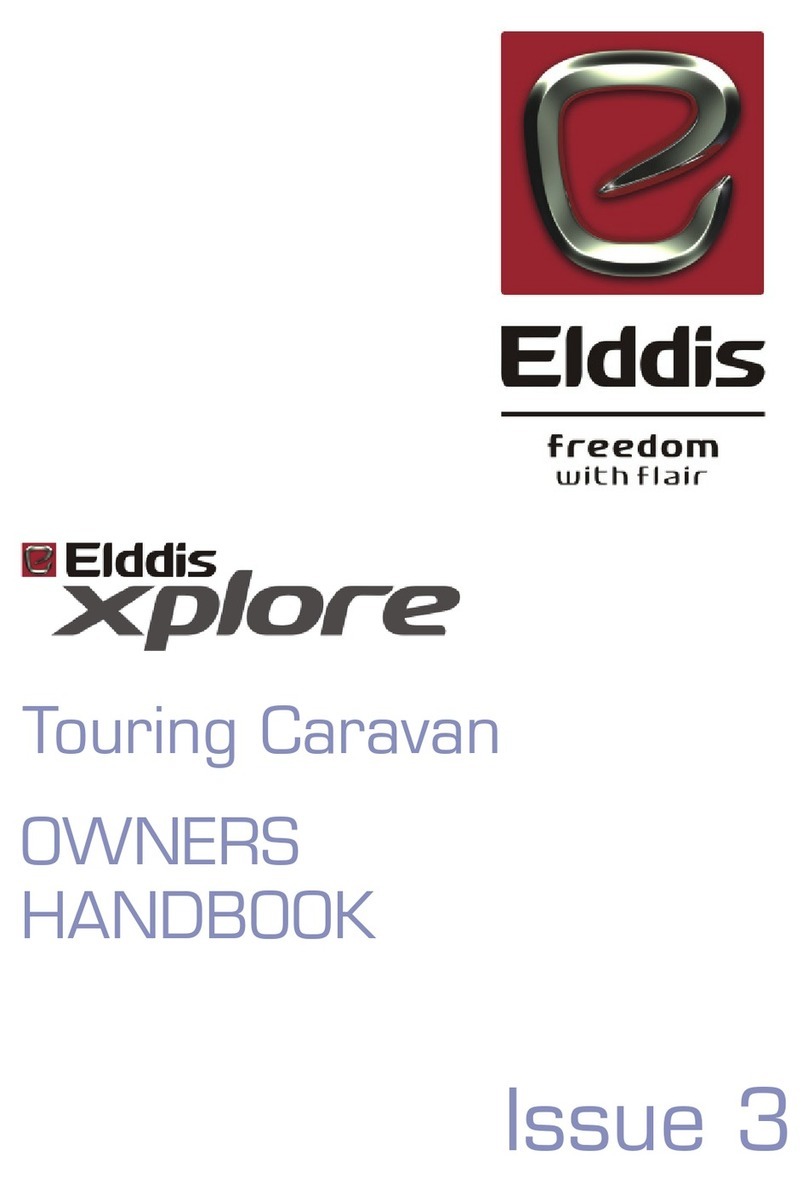
elddis
elddis 2011 Xplore 302 User guide

elddis
elddis Accordo 2021 User manual

elddis
elddis AVANTE User guide

elddis
elddis AVANTE User guide
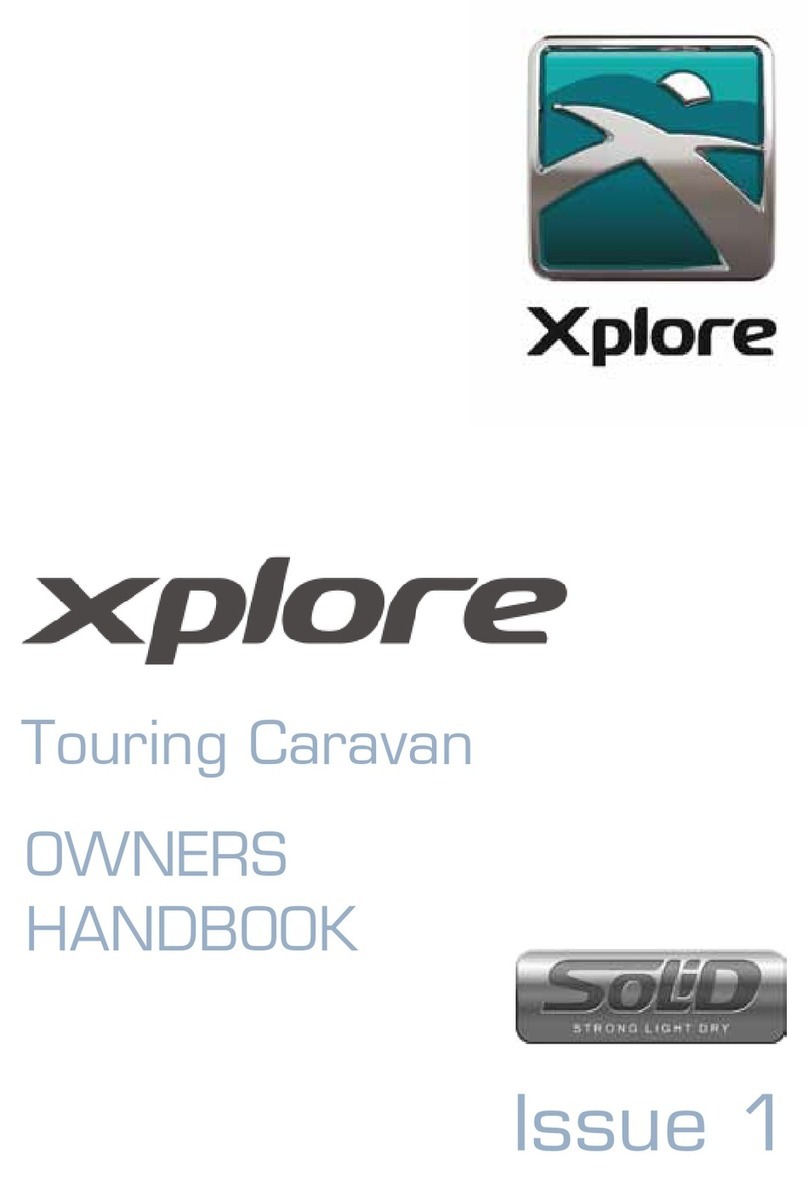
elddis
elddis XPLORE User guide
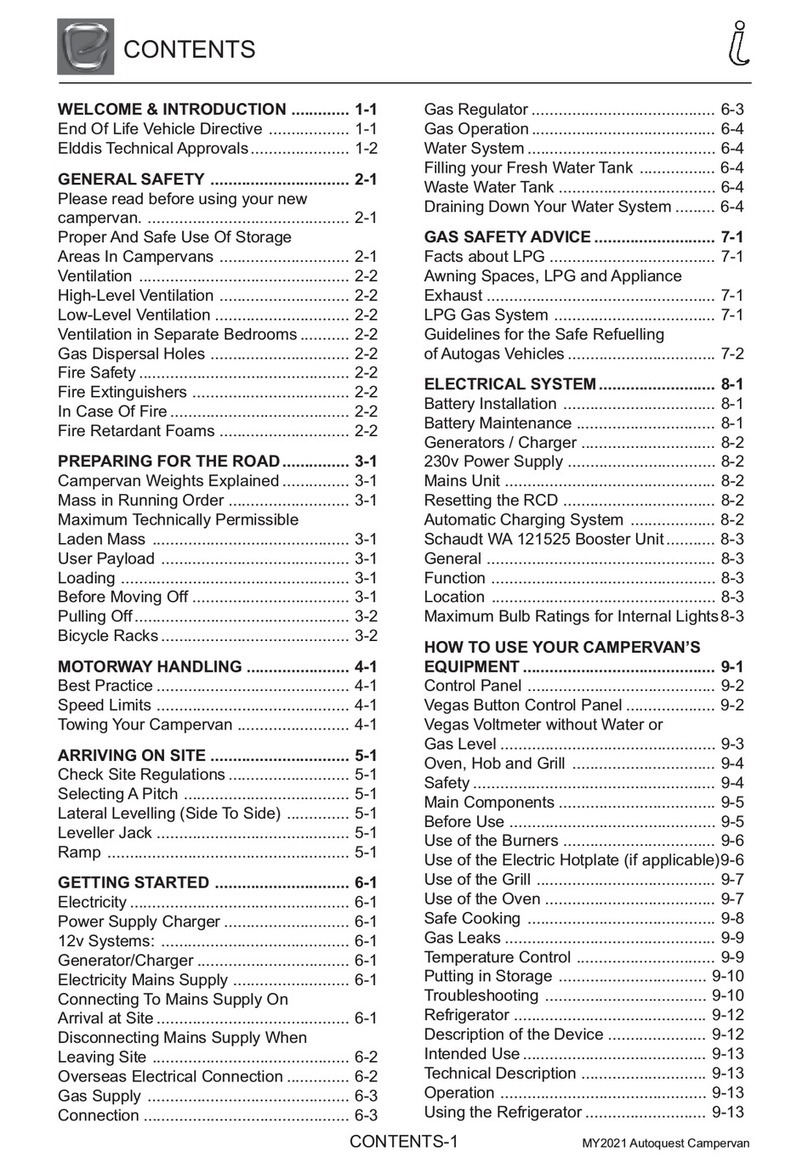
elddis
elddis Autoquest 2021 User manual

elddis
elddis 2016 Buccaneer User guide
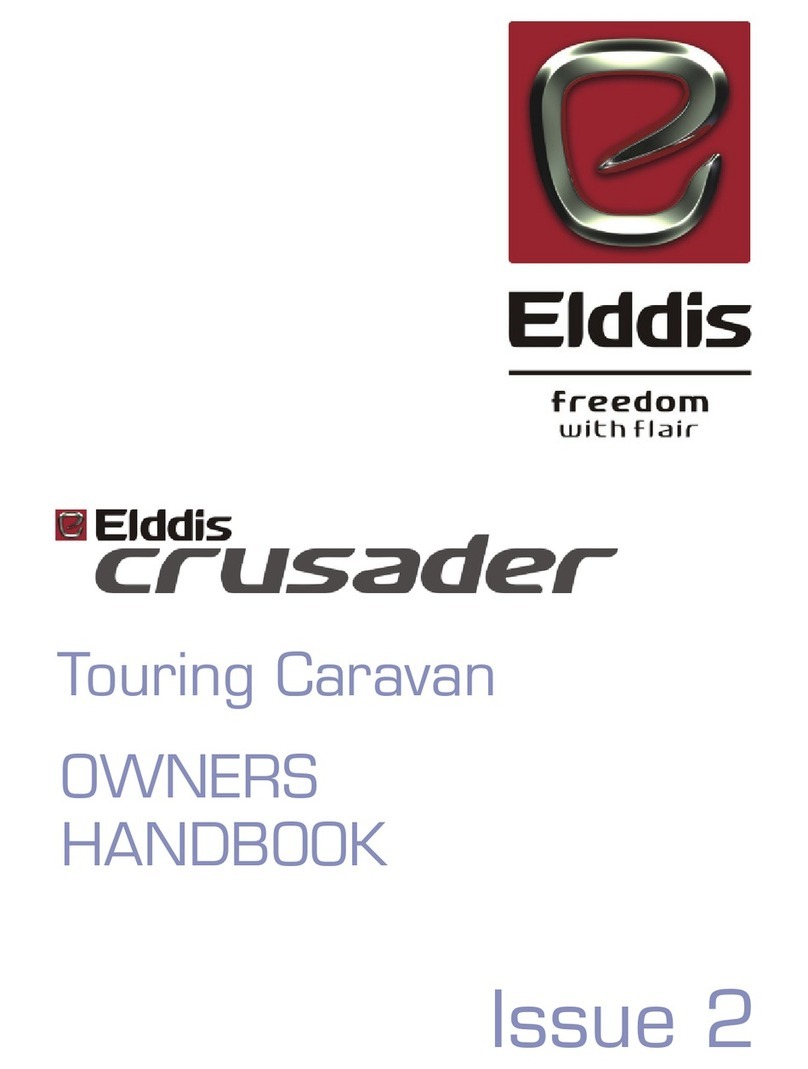
elddis
elddis Crusader User guide
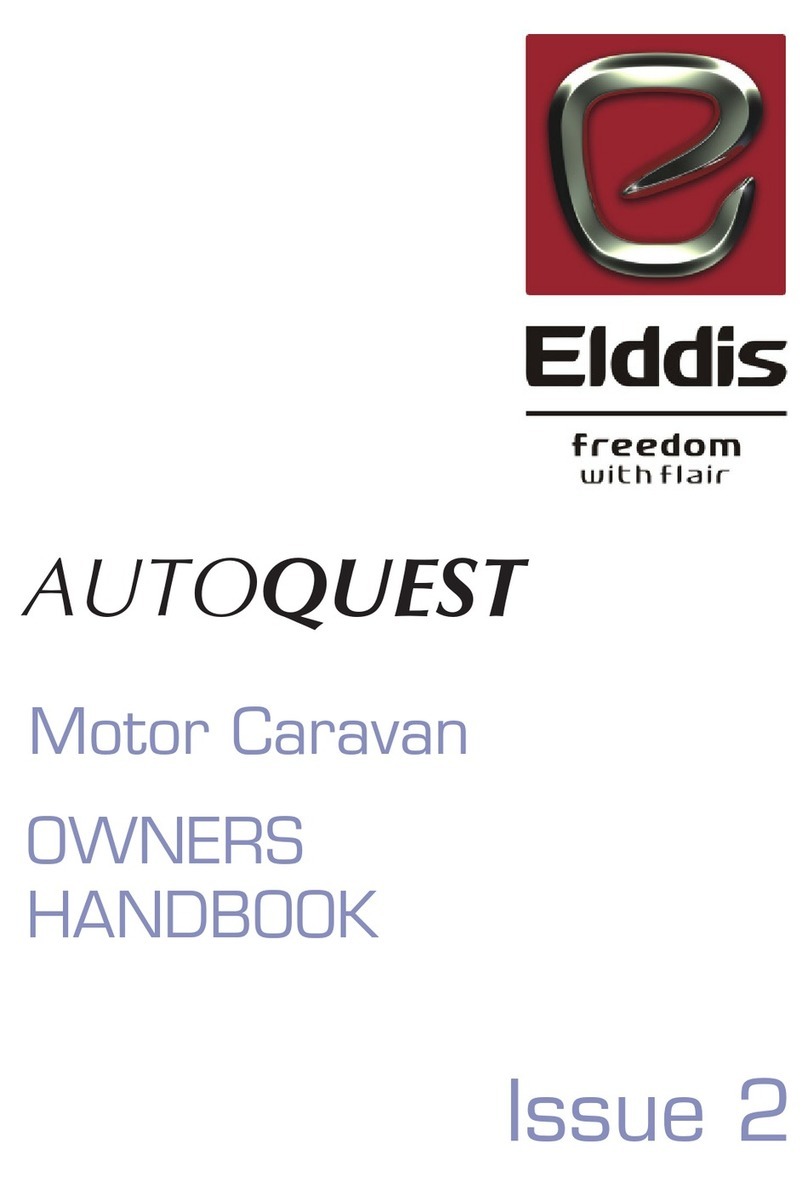
elddis
elddis AutoQuest User guide
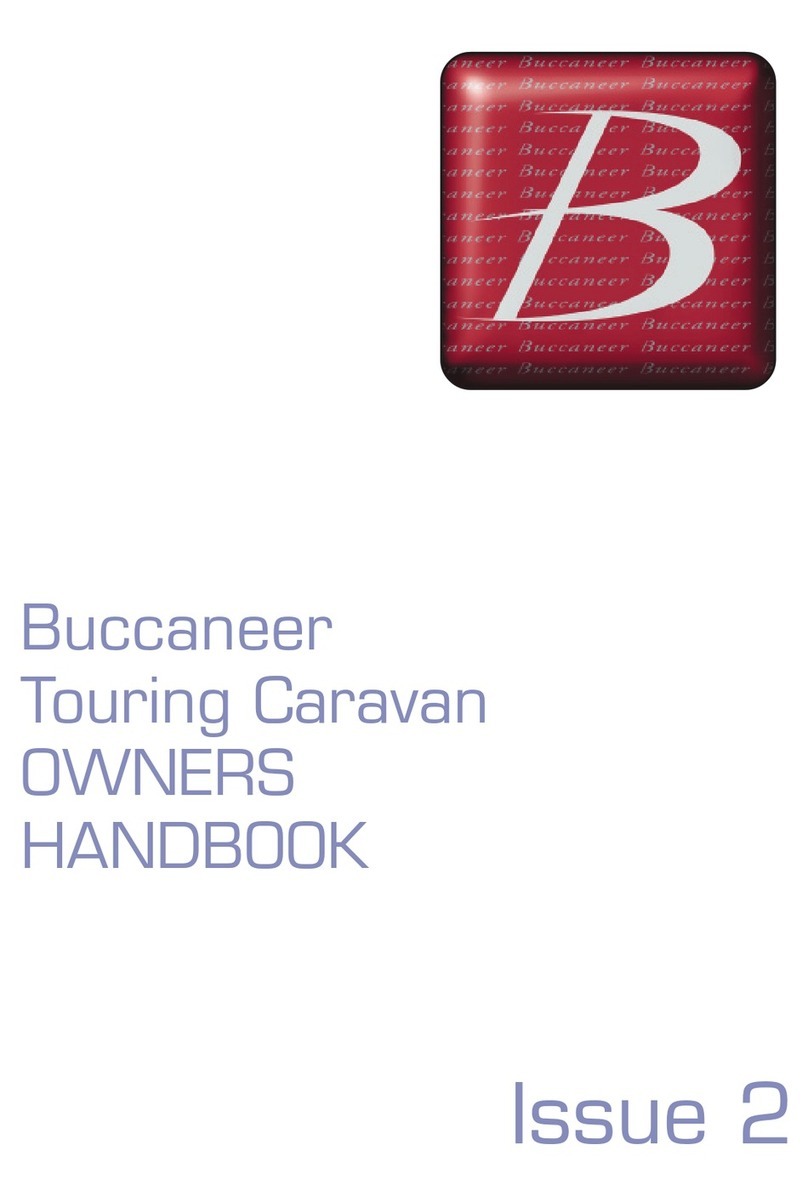
elddis
elddis Buccaneer User guide
